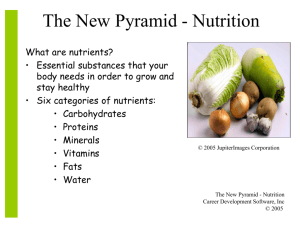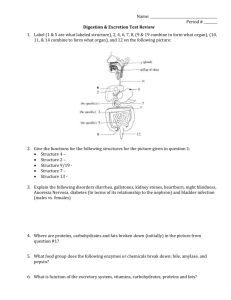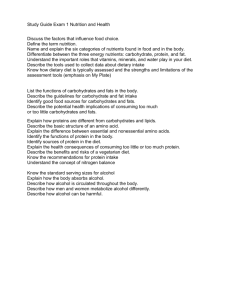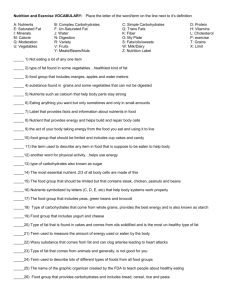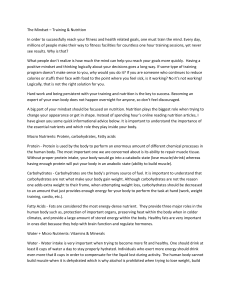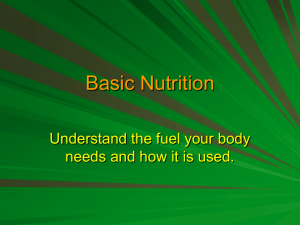Document 9581378
advertisement
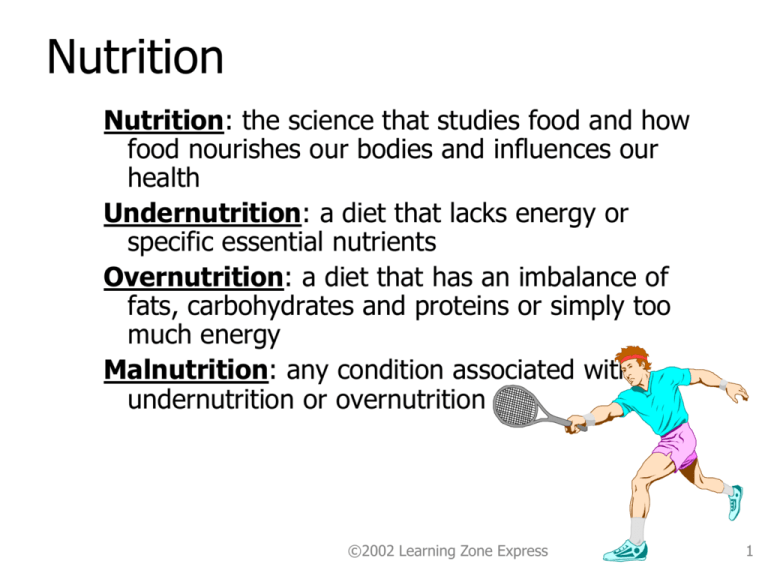
Nutrition Nutrition: the science that studies food and how food nourishes our bodies and influences our health Undernutrition: a diet that lacks energy or specific essential nutrients Overnutrition: a diet that has an imbalance of fats, carbohydrates and proteins or simply too much energy Malnutrition: any condition associated with undernutrition or overnutrition Maintain basic bodily functions ©2002 Learning Zone Express 1 Nutrients Essential nutrients: nutrients that must come from food or nutrient supplements because they are not manufactured by the body at all or not in amounts sufficient to meet the body’s needs Macronutrients: nutrients that our bodies need in relatively large amounts to suport normal function and health (carbohydrates, fats and proteins) Micronutrients: nutrients neededin relatively small amounts to support normal health and body functions (vitamins and minerals) Organic vs Inorganic Organic Nutrients: a nutrient that contains the element carbon Inorganic Nutrients: a nutrient that does not contain carbon carbon The New Pyramid - Nutrition What are nutrients? • Essential substances that your body needs in order to grow and stay healthy • Six categories of nutrients: • Carbohydrates • Proteins • Fats • Minerals • Vitamins • Water © 2005 JupiterImages Corporation The New Pyramid - Nutrition Career Development Software, Inc © 2005 Carbohydrates Carbohydrates Function • The main source of energy for our bodies • 1 gram contains 4 kilocalories (17 KJ) of energy Structure • Made of carbon, hydrogen and oxygen The New Pyramid - Nutrition Career Development Software, Inc © 2005 © 2005 JupiterImages Corporation Fat (Lipids) Functions: • A source of energy when our bodies are at rest • 1 gram contains 9 kilocalories (37 KJ) of energy Structure: • Made of carbon, hydrogen and oxgyen • Include triglycerides (fats), phospholipids and sterols © 2005 JupiterImages Corporation Fat (Lipids) More about Function • Stored triglycerides (fats) in adipose (fat) tissue can be broken down for energy when no carbohydrates are available • Are important for obtaining fatsoluble vitamins and essential fatty acids © 2005 JupiterImages Corporation Protein Function: • Provide the building materials your body needs to grow and repair itself • Can provide energy but are not generally used for this purpose • 1 gram contains 4 kilocalories (17 KJ) of energy Structure: • contains hydrogen, oxygen, carbon and nitrogen • Are long chains made of amino acids © 2005 JupiterImages Corporation Protein More about Function Proteins are involved in: • building new cells and tissues, • maintaining the structure and strength of bone, • Repairing damaged structures, and • Assisting in regulating metabolism and fluid balance © 2005 JupiterImages Corporation Vitamins • are organic compounds that assist in regulating many body processes such as bone and muscle tissue maintenance, immune system, vision, etc. • Vitamins are either fat-soluble or water-soluable ©2002 Learning Zone Express 10 Minerals • are inorganic substances (no carbon) that are not broken down during digestion and absorption and are not destroyed by heat or light – Important for nearly all aspects of human health and functionMinerals actually become part of the body. – The body requires 16 minerals daily. ©2002 Learning Zone Express 11 Water • Inorganic nutrient vital for survival • Required to maintain the proper balance of fluid both inside and outside our cells • Assists in the regulation of nerve impulses, muscle contractions, nutrient transport, and excretion of wastes It is recommended that teens drink 6-8 glasses (8 fl.oz each) of water each day. This is in addition to around 4 cups of water you get from food each day. ©2002 Learning Zone Express 12 9. Large intestine 10. Small intestine The digestive tract: tube through which food travels Accessory organs: organs through which food never travels (liver, gall bladder and pancreas) Seatwork/Homework Using page 404 and 405 Answer questions 1, 2 and 3 (internet required) Carbohydrates Carbohydrates • Structure and function: Carbohydrates are sugars and starches that the body uses for ENERGY! • PLANTS are the major source of carbohydrates in the food we eat. Simple Carbohydrates • Sugars that are quickly digested and provide a BOOST of energy for the body • Foods with LOTS of sugar: oranges, milk, cookies, candy The New Pyramid - Nutrition Career Development Software, Inc © 2005 © 2005 JupiterImages Corporation Carbohydrates Complex Carbohydrates • Starches that are composed of many sugars linked together • They provide the body with long-term energy since they are digested more slowly than sugars. • Foods with LOTS of starch: rice, beans, potatoes © 2005 JupiterImages Corporation The New Pyramid - Nutrition Career Development Software, Inc © 2005 Protein Proteins • Structure: Proteins are made from many amino acids connected together in different arrangements. • Function: Provide the building materials your body needs to grow and repair itself © 2005 JupiterImages Corporation • 9 of the 20 amino acids are called essential amino acids because you must obtain them from the foods you eat since your body cannot make them. The New Pyramid - Nutrition Career Development Software, Inc © 2005 Protein Complete proteins: • Foods containing all the essential amino acids Examples: fish, meat, eggs, milk, cheese Incomplete proteins: • Foods that are missing some essential amino acids Examples: Legumes, nuts, whole grains The New Pyramid - Nutrition Career Development Software, Inc copyright 2005 Fat Functions: • ENERGY source for the body (more than carbs and proteins) • Help protect and cushion vital organs as well as joints • Insulate the body Structure: • Fats belong to a group of organic compounds called lipids which are substances that do not dissolve in water. • Fatty acids are the building blocks of fats. © 2005 JupiterImages Corporation Fat Unsaturated fats: • Contain fatty acids that are missing hydrogen atoms • At room temperature, they are typically in liquid form. • They are less harmful to the circulatory system than saturated fats. • Foods with a lot of unsaturated fat: canola, safflower, and peanut oils The New Pyramid - Nutrition Career Development Software, Inc © 2005 © 2005 JupiterImages Corporation Fat Saturated fats: • Contain fatty acids with the MAXIMUM amount of hydrogen atoms • At room temperature, they are typically in solid form. © 2005 JupiterImages Corporation • Diets with TOO MUCH saturated fat have been known to cause heart disease. • Foods with a lot of saturated fat: beef fat, egg yolks, dairy products The New Pyramid - Nutrition Career Development Software, Inc copyright 2005 Calories What is a calorie? • The energy obtained from carbohydrates, proteins, and fats is measured in units called calories. © 2005 JupiterImages Corporation The New Pyramid - Nutrition Career Development Software, Inc copyright 2005 Bibliography “Benefits of Exercise.” Healthclubs.com. 2005. IHRSA.org. 19 Sept. 2005. <http://www.healthclubs.com/benefits/>. “Fad Diets: What You Need to Know.” Familydoctor.org. Apr. 2005. American Academy of Family Physicians. 19 Sept. 2005. <http://familydoctor.org/784.xml>. “Glossary.” Beaumont Hospitals. 2005. William Beaumont Hospitals. 19 Sept. 2005. <http://www.beaumonthospitals.com>. Holt, Rinehart, and Winston. Life Science (Teacher Edition). Prentice Hall. Englewood Cliffs, New Jersey., 2005. “Iron – Sources and Functions.” Nutrition and Fitness Software by NutriStrategy. 2005. NutriStrategy. 19 Sept. 2005. <http://www.nutristrategy.com/nutrition/iron.htm>. Kemp, Gina, M.A., and Robert Segal, M.A. “Healthy Restaurant Eating / Fast Food Nutrition: Guide to Making Healthy Choices.” Helpguide.org. 10 June 2004. Rotary Club of Santa Monica. 19 Sept. 2005. <http://www.helpguide.org/aging/fast_food_nutrition.htm>. “Medline Plus Medical Encyclopedia.” Medline Plus. 9 July 2004. U.S. Library Of Medicine. 19 Sept. 2005. <http://www.nlm.nih.gov/medlineplus/ency/article/002468.htm>. Merki, Mary Bronson, Ph.D., Merki, Don, Ph.D. Health: A Guide to Wellness. Glencoe McGraw-Hill, 2001. “Vitamins.” A.D.A.M. Healthcare Center. 2005. New York Times Company. 19 Sept. 2005. <http://adam.about.com/encyclopedia/002399.htm>. “What does organic mean?.” PickYourOwn.org. 9 Jan. 2003. Benivia, LLC. 19 Sept. 2005. <http://www.pickyourown.org/organic.htm>.
